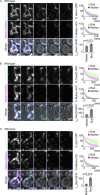Fission-independent compartmentalization of mitochondria during budding yeast cell division
- PMID: 38180475
- PMCID: PMC10783438
- DOI: 10.1083/jcb.202211048
Fission-independent compartmentalization of mitochondria during budding yeast cell division
Erratum in
-
Correction: Fission-independent compartmentalization of mitochondria during budding yeast cell division.J Cell Biol. 2024 Apr 1;223(4):e20221104803112024c. doi: 10.1083/jcb.20221104803112024c. Epub 2024 Mar 15. J Cell Biol. 2024. PMID: 38488722 Free PMC article. No abstract available.
Abstract
Lateral diffusion barriers compartmentalize membranes to generate polarity or asymmetrically partition membrane-associated macromolecules. Budding yeasts assemble such barriers in the endoplasmic reticulum (ER) and the outer nuclear envelope at the bud neck to retain aging factors in the mother cell and generate naïve and rejuvenated daughter cells. However, little is known about whether other organelles are similarly compartmentalized. Here, we show that the membranes of mitochondria are laterally compartmentalized at the bud neck and near the cell poles. The barriers in the inner mitochondrial membrane are constitutive, whereas those in the outer membrane form in response to stresses. The strength of mitochondrial diffusion barriers is regulated positively by spatial cues from the septin axis and negatively by retrograde (RTG) signaling. These data indicate that mitochondria are compartmentalized in a fission-independent manner. We propose that these diffusion barriers promote mitochondrial polarity and contribute to mitochondrial quality control.
© 2024 Yoshii and Barral.
Conflict of interest statement
Disclosures: The authors declare no competing interests exist.
Figures












References
Publication types
MeSH terms
Grants and funding
LinkOut - more resources
Full Text Sources

